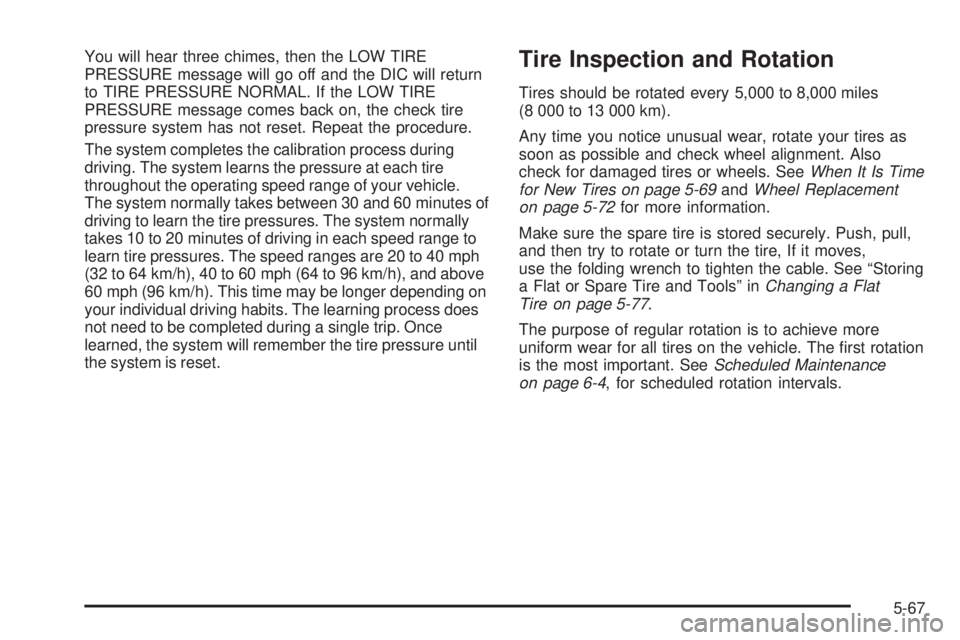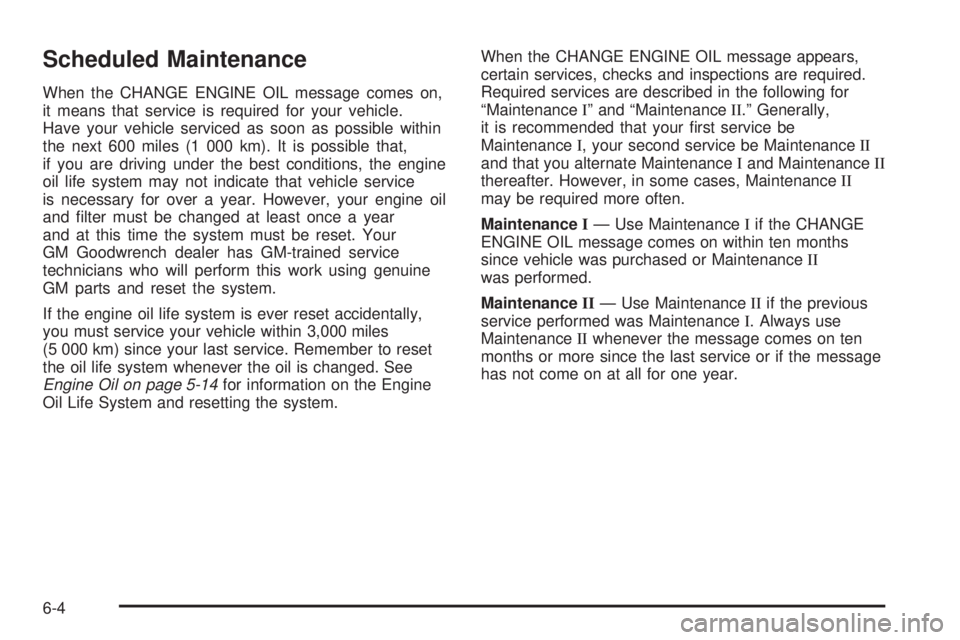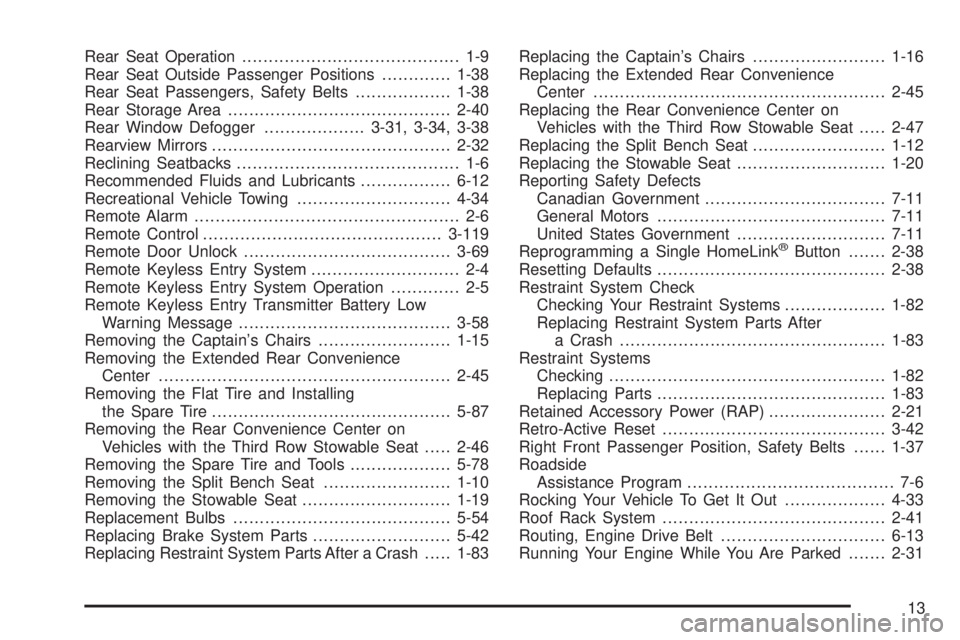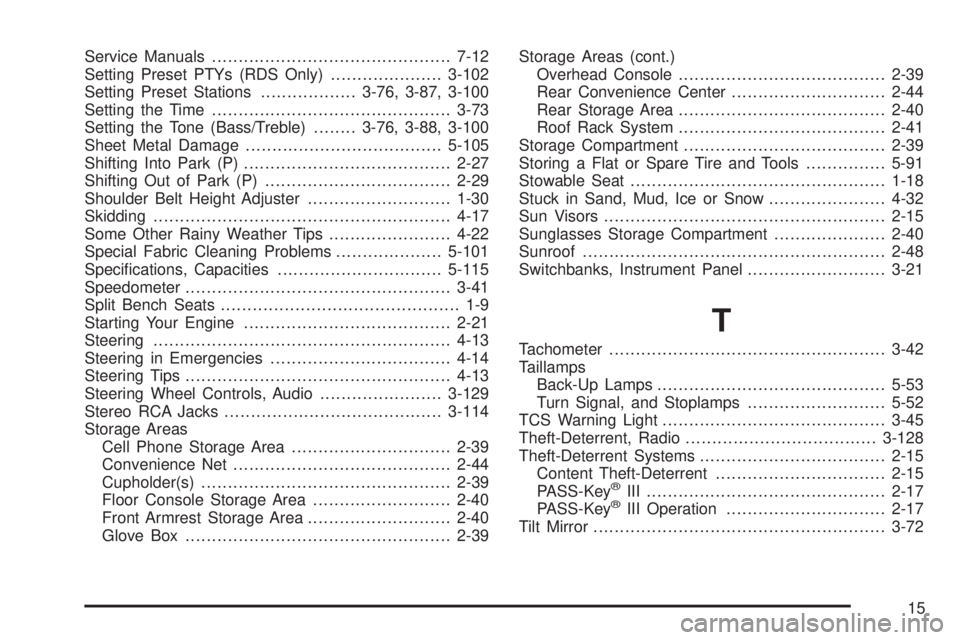reset BUICK RANDEZVOUS 2004 Owner's Guide
[x] Cancel search | Manufacturer: BUICK, Model Year: 2004, Model line: RANDEZVOUS, Model: BUICK RANDEZVOUS 2004Pages: 486, PDF Size: 3.18 MB
Page 389 of 486

You will hear three chimes, then the LOW TIRE
PRESSURE message will go off and the DIC will return
to TIRE PRESSURE NORMAL. If the LOW TIRE
PRESSURE message comes back on, the check tire
pressure system has not reset. Repeat the procedure.
The system completes the calibration process during
driving. The system learns the pressure at each tire
throughout the operating speed range of your vehicle.
The system normally takes between 30 and 60 minutes of
driving to learn the tire pressures. The system normally
takes 10 to 20 minutes of driving in each speed range to
learn tire pressures. The speed ranges are 20 to 40 mph
(32 to 64 km/h), 40 to 60 mph (64 to 96 km/h), and above
60 mph (96 km/h). This time may be longer depending on
your individual driving habits. The learning process does
not need to be completed during a single trip. Once
learned, the system will remember the tire pressure until
the system is reset.Tire Inspection and Rotation
Tires should be rotated every 5,000 to 8,000 miles
(8 000 to 13 000 km).
Any time you notice unusual wear, rotate your tires as
soon as possible and check wheel alignment. Also
check for damaged tires or wheels. SeeWhen It Is Time
for New Tires on page 5-69andWheel Replacement
on page 5-72for more information.
Make sure the spare tire is stored securely. Push, pull,
and then try to rotate or turn the tire, If it moves,
use the folding wrench to tighten the cable. See “Storing
a Flat or Spare Tire and Tools” inChanging a Flat
Tire on page 5-77.
The purpose of regular rotation is to achieve more
uniform wear for all tires on the vehicle. The �rst rotation
is the most important. SeeScheduled Maintenance
on page 6-4, for scheduled rotation intervals.
5-67
Page 390 of 486

When rotating your tires, always use the correct rotation
pattern shown here.
Don’t include the compact spare tire in your tire rotation.
After the tires have been rotated, adjust the front and
rear in�ation pressures as shown on the
Certi�cation/Tire label or the Tire and Loading
Information label.
Reset the check tire pressure system, if equipped. See
Check Tire Pressure System on page 5-65.
Make certain that all wheel nuts are properly tightened.
See “Wheel Nut Torque” underCapacities and
Speci�cations on page 5-115.
{CAUTION:
Rust or dirt on a wheel, or on the parts to
which it is fastened, can make wheel nuts
become loose after a time. The wheel could
come off and cause an accident. When you
change a wheel, remove any rust or dirt from
places where the wheel attaches to the vehicle.
In an emergency, you can use a cloth or a
paper towel to do this; but be sure to use a
scraper or wire brush later, if you need to, to
get all the rust or dirt off. See “Changing a Flat
Tire” in the Index.
5-68
Page 394 of 486

Temperature – A, B, C
The temperature grades are A (the highest), B, and C,
representing the tire’s resistance to the generation
of heat and its ability to dissipate heat when tested
under controlled conditions on a speci�ed indoor
laboratory test wheel. Sustained high temperature can
cause the material of the tire to degenerate and
reduce tire life, and excessive temperature can lead to
sudden tire failure. The grade C corresponds to a
level of performance which all passenger car tires must
meet under the Federal Motor Vehicle Safety Standard
No. 109. Grades B and A represent higher levels of
performance on the laboratory test wheel than the
minimum required by law.
Warning: The temperature grade for this tire is
established for a tire that is properly in�ated and not
overloaded. Excessive speed, underin�ation, or
excessive loading, either separately or in combination,
can cause heat buildup and possible tire failure.
Wheel Alignment and Tire Balance
The wheels on your vehicle were aligned and balanced
carefully at the factory to give you the longest tire life
and best overall performance.Scheduled wheel alignment and wheel balancing are
not needed. However, if you notice unusual tire wear or
your vehicle pulling one way or the other, the alignment
may need to be reset. If you notice your vehicle
vibrating when driving on a smooth road, your wheels
may need to be rebalanced.
Wheel Replacement
Replace any wheel that is bent, cracked or badly rusted
or corroded. If wheel nuts keep coming loose, the
wheel, wheel bolts and wheel nuts should be replaced.
If the wheel leaks air, replace it (except some
aluminum wheels, which can sometimes be repaired).
See your dealer if any of these conditions exist.
Your dealer will know the kind of wheel you need.
Each new wheel should have the same load-carrying
capacity, diameter, width, offset and be mounted
the same way as the one it replaces.
If you need to replace any of your wheels, wheel bolts
or wheel nuts, replace them only with new GM
original equipment parts. This way, you will be sure to
have the right wheel, wheel bolts and wheel nuts
for your vehicle.
5-72
Page 442 of 486

Scheduled Maintenance
When the CHANGE ENGINE OIL message comes on,
it means that service is required for your vehicle.
Have your vehicle serviced as soon as possible within
the next 600 miles (1 000 km). It is possible that,
if you are driving under the best conditions, the engine
oil life system may not indicate that vehicle service
is necessary for over a year. However, your engine oil
and �lter must be changed at least once a year
and at this time the system must be reset. Your
GM Goodwrench dealer has GM-trained service
technicians who will perform this work using genuine
GM parts and reset the system.
If the engine oil life system is ever reset accidentally,
you must service your vehicle within 3,000 miles
(5 000 km) since your last service. Remember to reset
the oil life system whenever the oil is changed. See
Engine Oil on page 5-14for information on the Engine
Oil Life System and resetting the system.When the CHANGE ENGINE OIL message appears,
certain services, checks and inspections are required.
Required services are described in the following for
“MaintenanceI” and “MaintenanceII.” Generally,
it is recommended that your �rst service be
MaintenanceI, your second service be MaintenanceII
and that you alternate MaintenanceIand MaintenanceII
thereafter. However, in some cases, MaintenanceII
may be required more often.
MaintenanceI— Use MaintenanceIif the CHANGE
ENGINE OIL message comes on within ten months
since vehicle was purchased or MaintenanceII
was performed.
MaintenanceII— Use MaintenanceIIif the previous
service performed was MaintenanceI. Always use
MaintenanceIIwhenever the message comes on ten
months or more since the last service or if the message
has not come on at all for one year.
6-4
Page 443 of 486

Service MaintenanceIMaintenanceII
Change engine oil and �lter. Reset oil life system. SeeEngine Oil on
page 5-14.An Emission Control Service.••
Visually check for any leaks or damage.See footnote (j).••
Inspect engine air cleaner �lter. If necessary, replace �lter. SeeEngine Air
Cleaner/Filter on page 5-19.An Emission Control Service. See footnote †.••
Rotate tires and check in�ation pressures and wear. SeeTires on page 5-57.••
Inspect brake system.See footnote (a).••
Check engine coolant and windshield washer �uid levels and add �uid as
needed.••
Perform any needed additional services. See “Additional Required Services” in
this section.••
Inspect suspension and steering components.See footnote (b).•
Inspect engine cooling system.See footnote (c).•
Inspect wiper blades.See footnote (d).•
Inspect restraint system components.See footnote (e).•
Lubricate body components.See footnote (f).•
Check transaxle �uid level and add �uid as needed.•
Inspect throttle system.See footnote (j).•
6-5
Page 481 of 486

Rear Seat Operation......................................... 1-9
Rear Seat Outside Passenger Positions.............1-38
Rear Seat Passengers, Safety Belts..................1-38
Rear Storage Area..........................................2-40
Rear Window Defogger...................3-31, 3-34, 3-38
Rearview Mirrors.............................................2-32
Reclining Seatbacks.......................................... 1-6
Recommended Fluids and Lubricants.................6-12
Recreational Vehicle Towing.............................4-34
Remote Alarm.................................................. 2-6
Remote Control.............................................3-119
Remote Door Unlock.......................................3-69
Remote Keyless Entry System............................ 2-4
Remote Keyless Entry System Operation............. 2-5
Remote Keyless Entry Transmitter Battery Low
Warning Message........................................3-58
Removing the Captain’s Chairs.........................1-15
Removing the Extended Rear Convenience
Center.......................................................2-45
Removing the Flat Tire and Installing
the Spare Tire.............................................5-87
Removing the Rear Convenience Center on
Vehicles with the Third Row Stowable Seat.....2-46
Removing the Spare Tire and Tools...................5-78
Removing the Split Bench Seat........................1-10
Removing the Stowable Seat............................1-19
Replacement Bulbs.........................................5-54
Replacing Brake System Parts..........................5-42
Replacing Restraint System Parts After a Crash.....1-83Replacing the Captain’s Chairs.........................1-16
Replacing the Extended Rear Convenience
Center.......................................................2-45
Replacing the Rear Convenience Center on
Vehicles with the Third Row Stowable Seat.....2-47
Replacing the Split Bench Seat.........................1-12
Replacing the Stowable Seat............................1-20
Reporting Safety Defects
Canadian Government..................................7-11
General Motors...........................................7-11
United States Government............................7-11
Reprogramming a Single HomeLink
®Button.......2-38
Resetting Defaults...........................................2-38
Restraint System Check
Checking Your Restraint Systems...................1-82
Replacing Restraint System Parts After
a Crash..................................................1-83
Restraint Systems
Checking....................................................1-82
Replacing Parts...........................................1-83
Retained Accessory Power (RAP)......................2-21
Retro-Active Reset..........................................3-42
Right Front Passenger Position, Safety Belts......1-37
Roadside
Assistance Program....................................... 7-6
Rocking Your Vehicle To Get It Out...................4-33
Roof Rack System..........................................2-41
Routing, Engine Drive Belt...............................6-13
Running Your Engine While You Are Parked.......2-31
13
Page 483 of 486

Service Manuals.............................................7-12
Setting Preset PTYs (RDS Only).....................3-102
Setting Preset Stations..................3-76, 3-87, 3-100
Setting the Time.............................................3-73
Setting the Tone (Bass/Treble)........3-76, 3-88, 3-100
Sheet Metal Damage.....................................5-105
Shifting Into Park (P).......................................2-27
Shifting Out of Park (P)...................................2-29
Shoulder Belt Height Adjuster...........................1-30
Skidding........................................................4-17
Some Other Rainy Weather Tips.......................4-22
Special Fabric Cleaning Problems....................5-101
Speci�cations, Capacities...............................5-115
Speedometer..................................................3-41
Split Bench Seats............................................. 1-9
Starting Your Engine.......................................2-21
Steering........................................................4-13
Steering in Emergencies..................................4-14
Steering Tips..................................................4-13
Steering Wheel Controls, Audio.......................3-129
Stereo RCA Jacks.........................................3-114
Storage Areas
Cell Phone Storage Area..............................2-39
Convenience Net.........................................2-44
Cupholder(s)...............................................2-39
Floor Console Storage Area..........................2-40
Front Armrest Storage Area...........................2-40
Glove Box..................................................2-39Storage Areas (cont.)
Overhead Console.......................................2-39
Rear Convenience Center.............................2-44
Rear Storage Area.......................................2-40
Roof Rack System.......................................2-41
Storage Compartment......................................2-39
Storing a Flat or Spare Tire and Tools...............5-91
Stowable Seat................................................1-18
Stuck in Sand, Mud, Ice or Snow......................4-32
Sun Visors.....................................................2-15
Sunglasses Storage Compartment.....................2-40
Sunroof.........................................................2-48
Switchbanks, Instrument Panel..........................3-21
T
Tachometer....................................................3-42
Taillamps
Back-Up Lamps...........................................5-53
Turn Signal, and Stoplamps..........................5-52
TCS Warning Light..........................................3-45
Theft-Deterrent, Radio....................................3-128
Theft-Deterrent Systems...................................2-15
Content Theft-Deterrent................................2-15
PASS-Key
®III .............................................2-17
PASS-Key®III Operation..............................2-17
Tilt Mirror.......................................................3-72
15